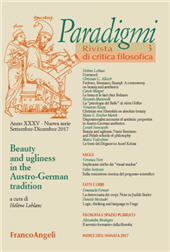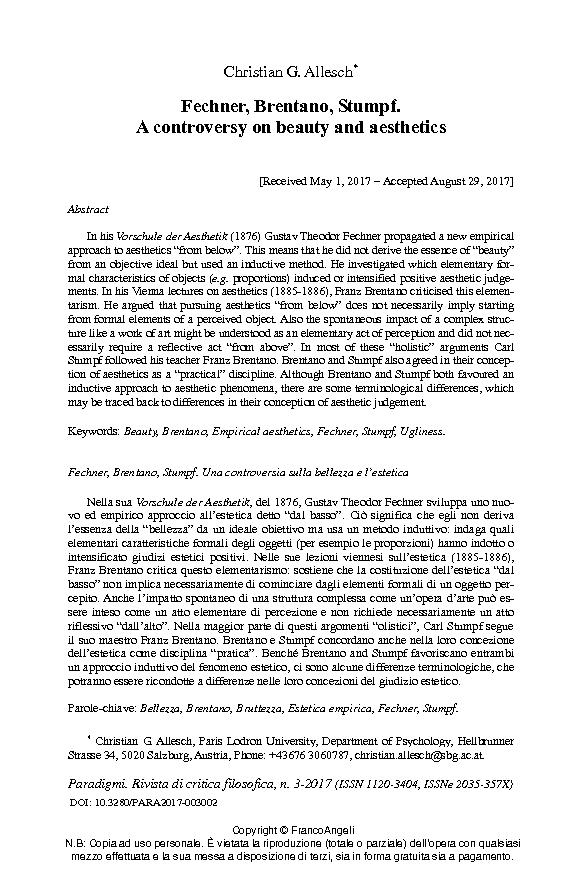Fechner, Brentano, Stumpf : a controversy on beauty and aesthetics
11-23 p.
Nella sua Vorschule der Aesthetik, del 1876, Gustav Theodor Fechner sviluppa uno nuovo ed empirico approccio all'estetica detto "dal basso". Ciò significa che egli non deriva l'essenza della "bellezza" da un ideale obiettivo ma usa un metodo induttivo: indaga quali elementari caratteristiche formali degli oggetti (per esempio le proporzioni) hanno indotto o intensificato giudizi estetici positivi. Nelle sue lezioni viennesi sull'estetica (1885-1886), Franz Brentano critica questo elementarismo: sostiene che la costituzione dell'estetica "dal basso" non implica necessariamente di cominciare dagli elementi formali di un oggetto percepito. Anche l'impatto spontaneo di una struttura complessa come un'opera d'arte può essere inteso come un atto elementare di percezione e non richiede necessariamente un atto riflessivo "dall'alto". Nella maggior parte di questi argomenti "olistici", Carl Stumpf segue il suo maestro Franz Brentano. Brentano e Stumpf concordano anche nella loro concezione dell'estetica come disciplin
a "pratica". Benché Brentano and Stumpf favoriscano entrambi un approccio induttivo del fenomeno estetico, ci sono alcune differenze terminologiche, che potranno essere ricondotte a differenze nelle loro concezioni del giudizio estetico. [Testo dell'editore].
In his Vorschule der Aesthetik (1876) Gustav Theodor Fechner propagated a new empirical approach to aesthetics "from below". This means that he did not derive the essence of "beauty" from an objective ideal but used an inductive method. He investigated which elementary formal characteristics of objects (e.g. proportions) induced or intensified positive aesthetic judgements. In his Vienna lectures on aesthetics (1885-1886), Franz Brentano criticised this elementarism. He argued that pursuing aesthetics "from below" does not necessarily imply starting from formal elements of a perceived object. Also the spontaneous impact of a complex structure like a work of art might be understood as an elementary act of perception and did not necessarily require a reflective act "from above". In most of these "holistic" arguments Carl Stumpf followed his teacher Franz Brentano. Brentano and Stumpf also agreed in their conception of aesthetics as a "practical" discipline. Although Brentano and Stumpf both favoured an inductiv
e approach to aesthetic phenomena, there are some terminological differences, which may be traced back to differences in their conception of aesthetic judgement. [Publishers' text].
Fait partie de
Paradigmi : rivista di critica filosofica : XXXV, 3, 2017-
Articles du même numéro (disponibles individuellement)
-
Informations
Code DOI : 10.3280/PARA2017-003002
ISSN: 2035-357X
DISCIPLINES
KEYWORDS
- Stress, malattia coronarica ischemica, asse cervello-cuore, meditazione, cuore endocrino, sistema immunitario cardiaco
- Stress, ischemic heart disease, brain-heart axis, meditation, heart as endocrine gland, cardiac immune system



